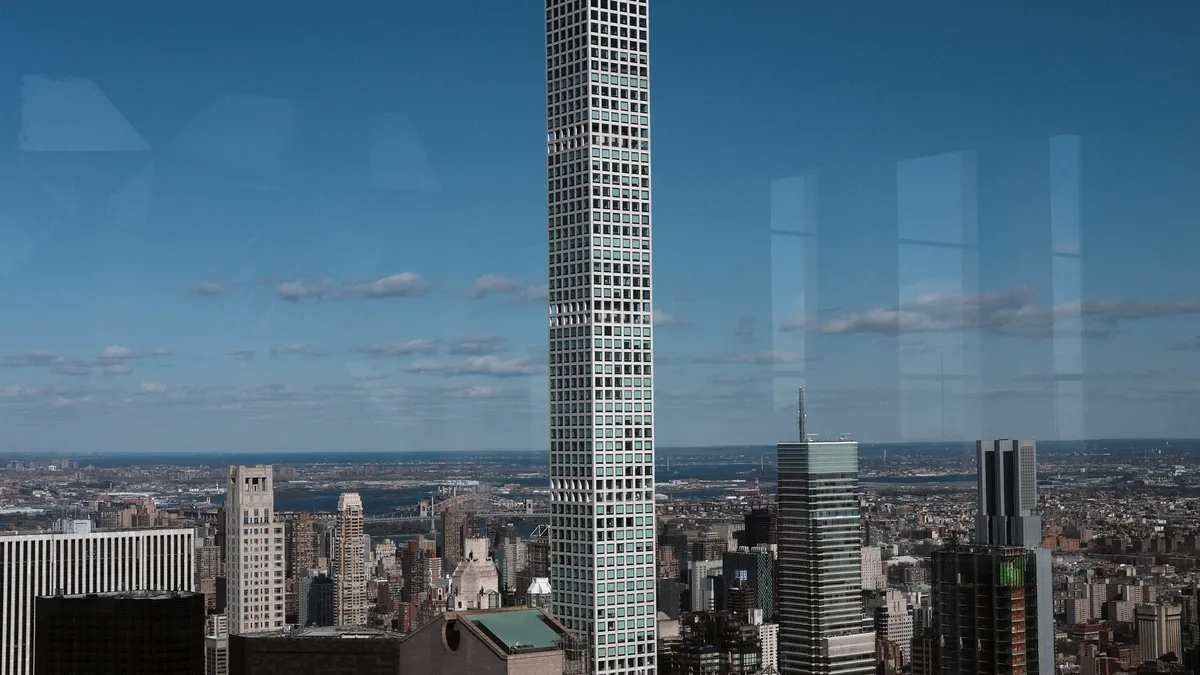Dive Brief:
- The condo board at 432 Park Avenue, a 1,396-foot-tall skyscraper overlooking Central Park in New York City that opened in 2015, is suing developers from CIM Group and Macklowe Properties and the company they formed to build the project, 56th and Park Owner LLC, "for damages arising from the multiple, extremely significant and much-publicized construction defects existing in the common elements and areas of the 102-story residential tower," according to court documents.
- In a lawsuit filed in the New York Supreme Court, the condo owners are asking for $250 million and punitive damages. They allege that the building was "riddled with over 1,500 identified construction and design defects" in common areas and added that many of those could be described as life safety issues. The suit does not include issues in individual units.
- The board claimed that the developers didn’t properly account for the skyscraper's height when designing the building, which created "horrible and obtrusive noise and vibrations." They also alleged botched repairs, arc-flash explosions and severe flooding and water damage (caused by poor plumbing installation) in the building. In addition, they said the elevators, which are programmed to slow down in high winds, have sometimes stopped completely, leaving occupants stuck for hours.
Dive Insight:
The problems at 432 Park Avenue aren’t new, but the recent suit filed by the condo association ramps up the dispute between residents and the developers.
"Unit owners paid tens of millions of dollars to acquire units," the plaintiffs said in court filings. "Far from the ultra-luxury spaces that they were promised, however, unit owners were sold a building plagued by breakdowns and failures that have endangered and inconvenienced residents, guests and workers, and repeatedly been the subject of highly critical accounts in the press and social media."
The building sponsor told Blomberg that its workers were blocked from making repairs by the condo owners, which delayed their completion.
Tyler Berding, an attorney and founding partner of Berding & Weil LLP in Walnut Creek, California, has litigated many construction suits and said it’s not unusual for condo associations to block repair work. While he doesn’t know the specifics of the 432 Park Avenue case, he says developers will send in teams to address more minor issues, but not the larger, complicated ones that often trigger litigation.
"Are they going to really fix it or are they just going to patch it and cover up the evidence, or destroy the evidence in the process?," Berding said. "It is very important as a lawyer representing an owner of a building like this to make sure that we have access to the original construction problem, and not something that has been changed or eliminated by some insufficient repair."
Once the condo association controls a building, Berding doesn't think work should move forward unless the residents, the developer and any consultants agree on what needs to be done.
Problems with taller buildings
These types of disputes between developers and condo associations are becoming more frequent as developers build taller buildings, according to Berding.
"We're seeing buildings on the West Coast and East Coast that are approaching levels that we've never seen before," Berding said.
As that happens, Berding contends that more errors, like noise issues and elevators that don’t function properly, are occurring. In litigating construction errors in these buildings, he is encountering problems that he has never seen before, although he doesn’t know whether those issues are the cause of 432 Park Avenue's woes.
Despite the problems at 432, the exterior design has earned kudos. It was a finalist in building information research company Emporis' annual Emporis Skyscraper Awards. Former Lendlease executive Ralph Esposito played a key role in the construction execution of the project.
Berding said that engineers don't have a large database on the performance of these taller structures.
"We have buildings in San Francisco that suffer enormous heat gain from the huge curtain wall glass that's on them," Berding said. "Things like that are a relatively recent occurrence as a consequence of the height or the mass of some of the buildings that they're trying to build now."
Eventually, though, the situation should improve. Once these construction defects have been litigated and developers have spent money to correct them, Berding said they would be less likely to occur.
"By the time you go through a couple of these same issues, the engineering community or the architectural community understands the nature of the problem better than they did and they're not likely to make the same mistake again," Berding said.














